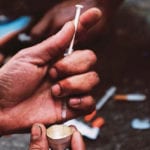 Mysteries
Mysteries  Mysteries
Mysteries  Miscellaneous
Miscellaneous 10 of History’s Most Bell-Ringing Finishing Moves
 History
History 10 Great Escapes That Ended Right Back in Captivity
 Weird Stuff
Weird Stuff 10 Fascinating Things You Might Not Know About Spiders
 Food
Food 10 Everyday Foods You Didn’t Know Were Invented by the U.S. Military
 History
History 10 Odd Things Colonial Americans Kept at Home
 Weird Stuff
Weird Stuff 10 Superstitious Beliefs That Once Consumed Entire Cultures
 History
History 10 Bizarre Friendly Fire Incidents in Military History
 Technology
Technology 10 Modern Technologies That Accidentally Imitate Ancient Magic
 Mysteries
Mysteries 10 Mysteries of the Human Genome
 Mysteries
Mysteries 10 Strange Unexplained Mysteries of 2025
 Miscellaneous
Miscellaneous 10 of History’s Most Bell-Ringing Finishing Moves
 History
History 10 Great Escapes That Ended Right Back in Captivity
Who's Behind Listverse?

Jamie Frater
Head Editor
Jamie founded Listverse due to an insatiable desire to share fascinating, obscure, and bizarre facts. He has been a guest speaker on numerous national radio and television stations and is a five time published author.
More About Us Weird Stuff
Weird Stuff 10 Fascinating Things You Might Not Know About Spiders
 Food
Food 10 Everyday Foods You Didn’t Know Were Invented by the U.S. Military
 History
History 10 Odd Things Colonial Americans Kept at Home
 Weird Stuff
Weird Stuff 10 Superstitious Beliefs That Once Consumed Entire Cultures
 History
History 10 Bizarre Friendly Fire Incidents in Military History
 Technology
Technology 10 Modern Technologies That Accidentally Imitate Ancient Magic
 Mysteries
Mysteries 10 Mysteries of the Human Genome
10 Mutant Genes That Could Make You Superhuman
At some point, everyone has fantasized about being a superhero. Sure, the tights may be snug in some awkward places, but that’s a small price to pay to wield amazing powers against the forces of evil. Well, luckily, those dreams may be close to becoming reality. Geneticists are tracking down specific mutations responsible for some truly incredible abilities. From immunity to electricity to Hulk-like strength, these tremendous talents may soon be as normal as eating and breathing.
10Unbreakable Bones

A broken bone is a fantastic way to ruin your entire day (your entire several months, really). Despite being the hardest substance in the human body, bone is definitely not invulnerable. Unless you find yourself with an extremely rare mutation of the LRP5 gene, that is.
LRP5 is responsible for the density of your bones. Researchers have known for a while that mutations in this gene can lead to lower bone density, or osteoporosis. However, it has recently been found that they can lead to the opposite effect as well. One Connecticut family has been discovered to have LRP5 mutations that give their bones such incredible density that they are nearly unbreakable. Not one of them has ever suffered a broken bone. Focused on the spine, skull, and pelvis, this increased strength gives members of the family the strongest known skeletons on Earth.
Researchers believe this mutation causes too many “bone-growth signals” to be sent, leading to beefier bones and a potential superhero. It is hoped that one day, a controlled form of the mutant gene could be used to end bone disease.
9Super Speed

We all have the natural ability to run, if not always the will. Yet some people seem naturally better at this incredibly basic skill. Sure, it could be down to training or steroids, but geneticists believe the answer is nowhere near that.
It turns out naturally gifted runners may be more fit for the X-Men than the Olympics. The gene ACTN3 is present within every human body, but a small percentage of them mutate to help us produce a very special substance. This protein, alpha-actinin-3, is responsible for controlling the fast-twitch muscle fibers that allow us to run. Increased amounts lead to more explosive bursts of muscle power, which translate into better performance in all kinds of sports, especially sprinting.
Interestingly, there are two versions of this mutant gene, and athletes with both have been found to perform consistently better than their conventionally chromosomed counterparts. We may be on the brink of a new age of performance enhancement.
8Poison Immunity

When it comes to poison, the human body gets very fragile very quickly; a single drop of something like cyanide or ricin, and it’s all over. Whether accidentally ingested or snuck into our food, these sinister substances are hard to defend against.
But for millennia, the villagers of San Antonio de los Cobres in Argentina have been sipping mountain water laced with 80 times the safe level of arsenic. And, surprisingly, there are still villagers in San Antonio de los Cobres. Despite extreme daily exposure to the deadly metal, residents carry on completely unaffected. This is all down to a mutant gene that has been honed by thousands of years of natural selection.
AS3MT is the name of this South American savior. It allows the body to process arsenic rather than let it build to dangerous levels, so owners of these microscopic mutants can chow down on as much of the stuff as they want. It is estimated that a total of 6,000 people now possess this gene.
7Short-Sleeping

The life of a superhero is not an easy one. Working your mundane cover job during the day and prowling the rooftops by night doesn’t leave a lot of time for sleep. But if you’re lucky, your host of mutant abilities includes short-sleeping.
The genes involved in the process of sleep are many and incredibly complex. One, however, stands out to researchers. DEC2 is responsible for regulating the amount of sleep we need each night to properly function. For most of us it demands a full eight hours or more, but about 5 percent of the population enjoy a slightly different mutant version.
Tests on a mother-daughter pair with the mutation have revealed an ability to sleep just 4–6 hours each night. Mere mortals would begin to experience negative effects after just a few days of this, but these mutants function completely normally. Researchers are hopefully working to replicate this mutation to allow crime fighters and the exceptionally busy to waste less time unconscious.
6Shock-Proof Skin
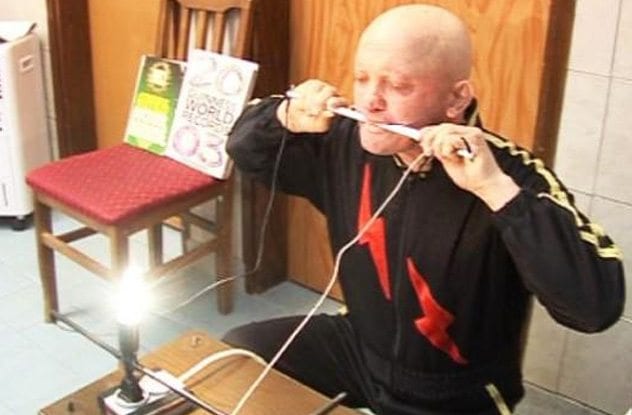
Electricity is one of the most dangerous things we encounter each day. We tend not to think much about it because we’re so used to it, but we are almost always surrounded by more than enough power to kill us in an instant. That’s never bothered Serbian man Slavisa Pajkic, though, whose unique genetic makeup makes him largely immune to electricity.
The typical human is covered with millions of sweat glands, which normally give electric shocks a nice wet path directly into our skin. Pajkic, on the other hand, has no sweat or salivary glands due to a rare genetic condition. This means electricity has no way of penetrating his body, so it skims harmlessly over his skin into whatever he happens to be holding.
This unique talent has earned Pajkic the title of “Battery Man.” Able to cook food, boil water, and even set things on fire by passing electricity over his body, he has set a handful of records and appeared on several TV shows. He also uses his gift to treat (or at least claim to treat them) various ailments like migraines and back pain in his native Serbia.
5Super Partying

The lifestyle of rich and famous musicians is notorious for being pretty hard on the body. Countless lives have been snuffed out prematurely due to the stresses of constant drug and alcohol use. But bizarrely, one of the men associated most strongly with this life of dangerous excess has been going strong for decades.
Rocker Ozzy Osbourne’s ironically long life may be due to more than simple luck. Researchers analyzing the legendary musician’s genetic code have recently discovered a staggering number of mutant genes. Most of them have to do with the way the body breaks down alcohol and various other chemicals. For instance, a mutation of the ADH4 gene gives him increased amounts of proteins that remove alcohol from the body. Genetic variations like this help explain Osbourne’s continued existence despite the “swimming pools of booze . . . cocaine, morphine, sleeping pills, cough syrup, LSD, Rohypnol” he has admitted to indulging in over the years.
4Metal Munching
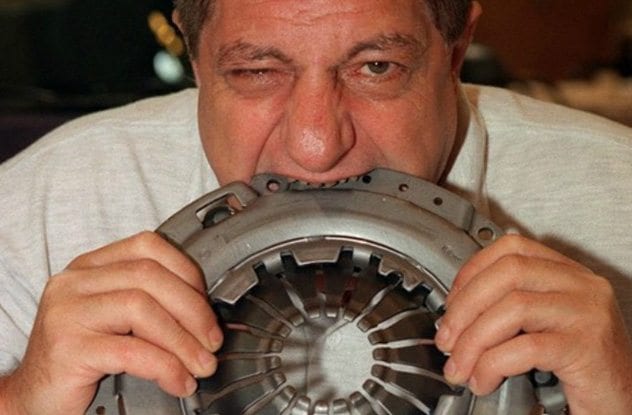
There comes a moment in every superhero’s career when defeat looks certain. The villain’s doomsday device is ticking away, and all hope seems lost. But luckily, the hero still has a genetic variation or two up his sleeve. He grabs it, adds a dash of salt, and crams it down his mighty throat. The day is saved.
But only if his name is Michel Lotito. This phenomenal French showman spent his life chowing down on absolutely everything as the amazing Monsieur Mangetout—Mr. Eats-All. Televisions, shopping carts, beds, and even an entire airplane made their way through his super-powered stomach. Swallowing shards of glass and twisted scraps of metal would of course kill most people, but Lotito survived his deadly eating habits for decades.
It is believed that Lotito’s stomach-turning talent was the result of a very specific genetic defect. Born with bizarrely thick lining in his stomach and intestines, his system was durable enough to avoid the inevitable shredding most people would experience. A few gulps of lubricating mineral oil were the only safety precaution he required.
3Super Flexibility
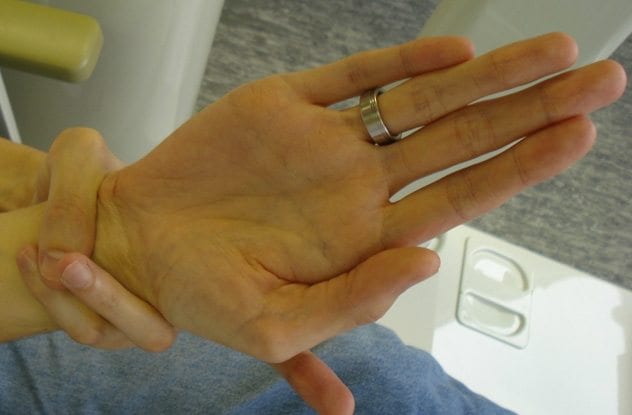
Inhuman flexibility has been a comic book staple for years. This is mostly because the ability to warp the body into bizarre and amazing shapes is dramatic and visually stunning. But its pop culture popularity may lead some to think of this talent as mere fiction. It isn’t.
For those born with the genetic condition known as Marfan Syndrome, tendons and ligaments may as well be rubber bands. Mutations in the gene responsible for producing the protein fibrillin-1 cause the body to create connective tissues with superhuman flexibility. Selectively dislocating joints to twist the body into shapes worthy of Mr. Fantastic is nothing for the typical Marfan sufferer.
Of course, this gift comes with a price. Sufferers may develop unnaturally long limbs and facial disfigurements. Problems with the skeleton, nervous system, and even the heart can also arise from the genetic defect, some of which can be fatal.
2Super Strength
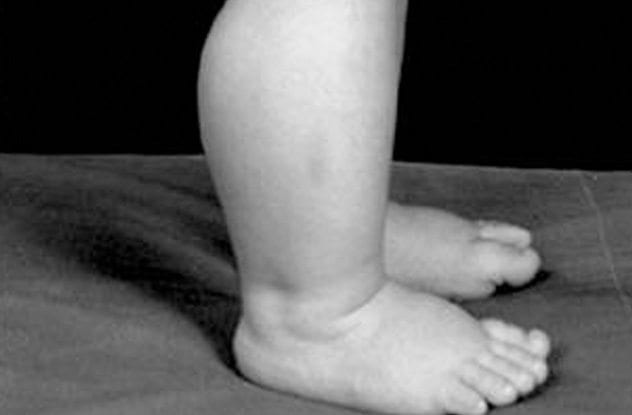
Super strength is the quintessential super power; it has been the go-to ability for comic book writers since Superman first flew onto the scene. The raw power it represents is fascinating, leaving many yearning for rippling muscles and brute strength with absolutely no effort. Well good news: It’s possible. Bad news: You have to be born with it.
For a lucky few born with mutations of the gene responsible for producing the protein myostatin, the dream of effortless abs is a reality. Myostatin tells the body to stop producing muscle when enough has been created, but defective genes keep it from being made. This means muscles automatically grow to twice the average size, while fat deposits are halved.
A handful of people around the world have this condition, and scientists are trying to harness its power. It is believed that by studying these mutant genes, we may one day be able to cure muscle conditions like muscular dystrophy.
1Immunity To Pain
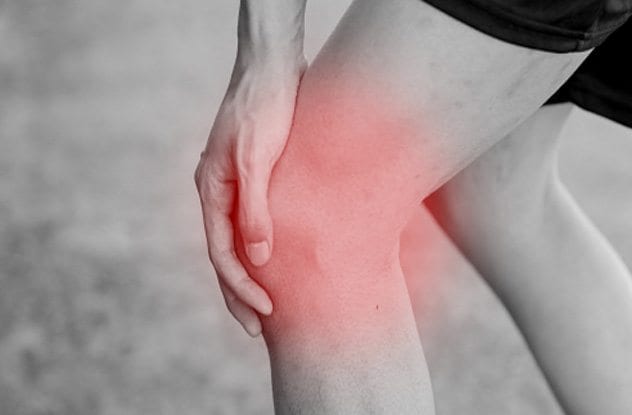
Pain. Whether by banging your toe on the corner of your bed, cutting yourself shaving, or walking into a door, we all experience this annoying sensation almost daily. Pharmaceutical companies make billions offering us ways to avoid it, but the secret to true painlessness may be hidden in the garbled genes of a very rare few.
The SCN11A gene determines the amount of sodium in the body’s cells. This might not sound terribly impressive, until you realize that nerve cells use sodium to decide when to send a pain signal. With the mutant gene lowering sodium levels, nerve cells never have enough to send those signals, rendering the body completely immune to pain.
Bizarrely, however, people with this seemingly enviable condition are prone to broken bones and accidental self-mutilation. Without pain to tell them not to do something, they have a tendency to injure themselves, especially as infants. Still, their mutant genes are incredibly rare and valuable, as they may be the key to revolutionary new pain medications.



